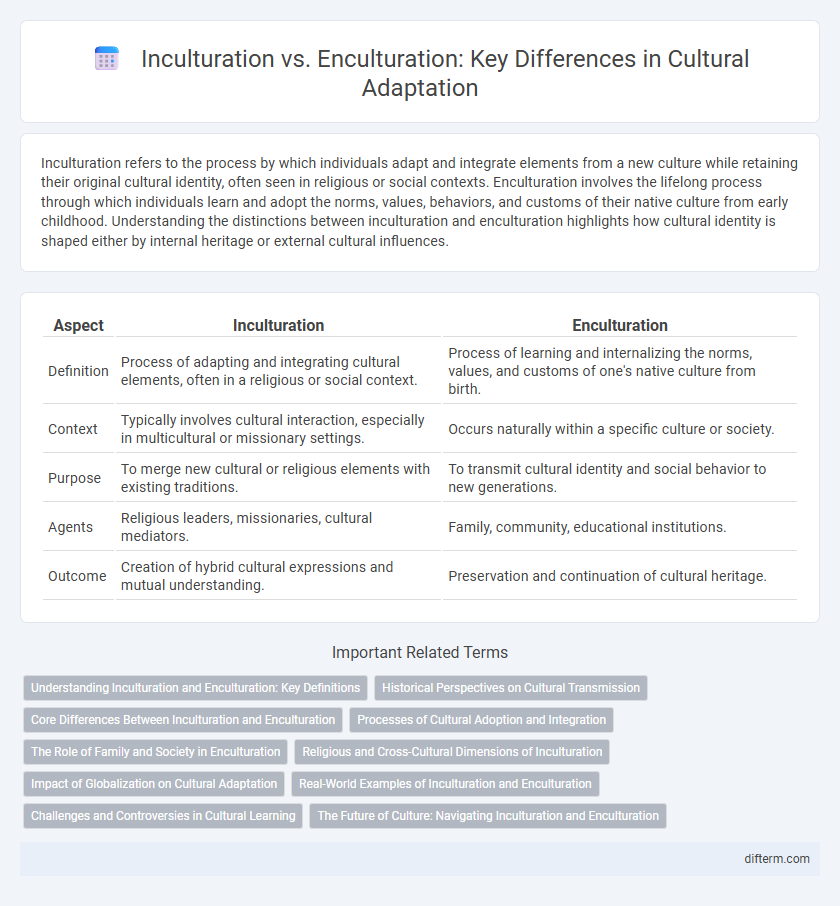Inculturation refers to the process by which individuals adapt and integrate elements from a new culture while retaining their original cultural identity, often seen in religious or social contexts. Enculturation involves the lifelong process through which individuals learn and adopt the norms, values, behaviors, and customs of their native culture from early childhood. Understanding the distinctions between inculturation and enculturation highlights how cultural identity is shaped either by internal heritage or external cultural influences.
Table of Comparison
| Aspect | Inculturation | Enculturation |
|---|---|---|
| Definition | Process of adapting and integrating cultural elements, often in a religious or social context. | Process of learning and internalizing the norms, values, and customs of one's native culture from birth. |
| Context | Typically involves cultural interaction, especially in multicultural or missionary settings. | Occurs naturally within a specific culture or society. |
| Purpose | To merge new cultural or religious elements with existing traditions. | To transmit cultural identity and social behavior to new generations. |
| Agents | Religious leaders, missionaries, cultural mediators. | Family, community, educational institutions. |
| Outcome | Creation of hybrid cultural expressions and mutual understanding. | Preservation and continuation of cultural heritage. |
Understanding Inculturation and Enculturation: Key Definitions
Inculturation refers to the process by which individuals or groups learn and adapt to a new culture, integrating its values, beliefs, and practices into their own identity. Enculturation involves the transmission of cultural norms and values from one generation to another within the same culture, shaping individuals' worldview from early childhood. Both concepts are essential for understanding cultural adaptation and identity formation in diverse social contexts.
Historical Perspectives on Cultural Transmission
Historical perspectives on cultural transmission reveal inculturation as the active process where individuals internalize new cultural beliefs, often through religious or colonial influences, reshaping identity. Enculturation involves the passive assimilation of cultural norms and values transmitted naturally within a community across generations. Anthropologists emphasize that while enculturation stabilizes cultural continuity, inculturation drives cultural change through external interactions.
Core Differences Between Inculturation and Enculturation
Inculturation involves the dynamic process by which an individual integrates and adapts new cultural elements into their existing belief system, often influenced by external religious or philosophical frameworks. Enculturation refers to the lifelong process through which individuals acquire and internalize the customs, values, and norms of their native culture from early childhood. Core differences lie in inculturation's emphasis on active adaptation and synthesis of diverse cultural elements, whereas enculturation focuses on passive absorption and transmission of a singular, inherited culture.
Processes of Cultural Adoption and Integration
Inculturation emphasizes the dynamic process of integrating cultural elements through ongoing interaction and adaptation, often involving religious or ideological transformation within a host culture. Enculturation refers to the passive acquisition of cultural norms and practices primarily through socialization within one's native community from a young age. Both processes shape cultural identity, with inculturation allowing for selective adoption and modification, while enculturation reinforces inherited traditions and values.
The Role of Family and Society in Enculturation
Family serves as the primary agent of enculturation, transmitting language, norms, and values directly through daily interactions. Society reinforces these cultural elements by providing institutions such as schools, peer groups, and religious organizations that shape behaviors and social expectations. Together, family and societal structures establish the foundation for an individual's cultural identity and social integration.
Religious and Cross-Cultural Dimensions of Inculturation
Inculturation involves the dynamic process by which religious beliefs and practices are adapted and expressed within diverse cultural contexts, fostering meaningful dialogue between faith and indigenous traditions. This process emphasizes the integration of religious values with local customs to enrich spiritual experience and promote cultural identity without losing doctrinal integrity. The cross-cultural dimensions of inculturation highlight the mutual influence between global religious frameworks and local cultures, enabling a harmonious coexistence and deeper understanding across cultural boundaries.
Impact of Globalization on Cultural Adaptation
Globalization accelerates cultural adaptation by intensifying both inculturation and enculturation processes, where individuals integrate foreign cultural elements (inculturation) while maintaining indigenous cultural identity (enculturation). The pervasive influence of global media, migration, and digital communication fosters hybrid cultural practices, challenging traditional boundaries and promoting cultural fluidity. This dynamic reshapes social norms, language use, and values, highlighting the transformative impact of globalization on cultural identity formation.
Real-World Examples of Inculturation and Enculturation
Inculturation is evident when Christian missionaries in Africa adapt religious teachings to local customs, integrating traditional dances and festivals into worship to resonate with indigenous beliefs. Enculturation occurs as children in Japan learn societal norms and values through family and school, absorbing practices like bowing and group harmony from early childhood. These examples highlight how inculturation involves blending external cultural elements into existing traditions, while enculturation is the unconscious absorption of native culture through daily socialization.
Challenges and Controversies in Cultural Learning
Inculturation presents challenges in balancing respect for indigenous beliefs with the introduction of new religious or cultural elements, often leading to controversies over cultural identity and autonomy. Enculturation may face difficulties in preserving traditional values amidst rapidly changing societal norms and globalization, causing generational conflicts and cultural erosion. Both processes provoke debates on cultural authenticity and the ethical implications of cultural adaptation and assimilation.
The Future of Culture: Navigating Inculturation and Enculturation
Inculturation involves the adaptation of cultural elements from one group into another, promoting dynamic cultural exchange and transformation. Enculturation, on the other hand, is the process through which individuals learn and internalize their native culture's norms, values, and practices from birth. Navigating the future of culture requires balancing these processes to foster cultural continuity while embracing innovation and diversity amid globalization.
inculturation vs enculturation Infographic

 difterm.com
difterm.com